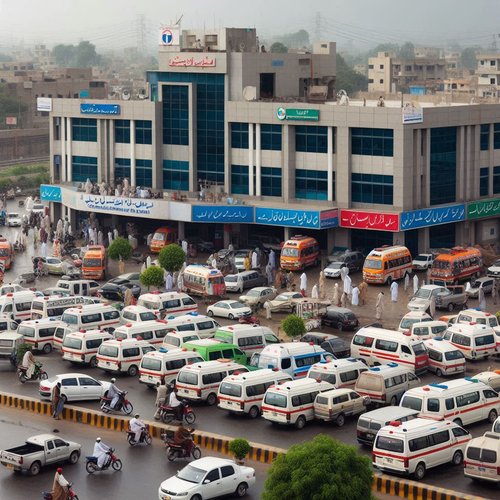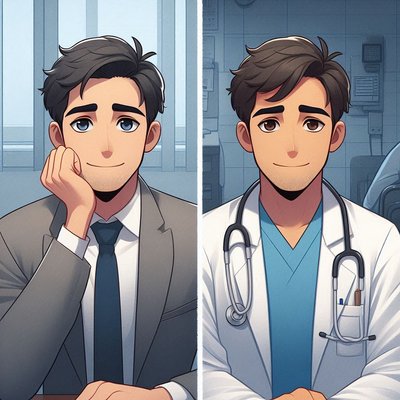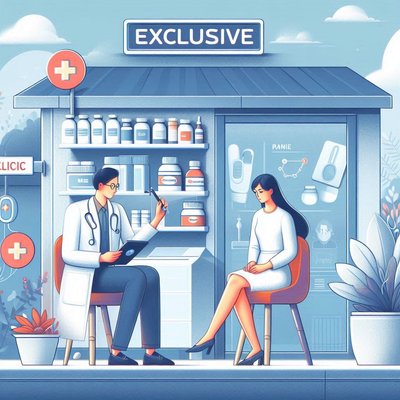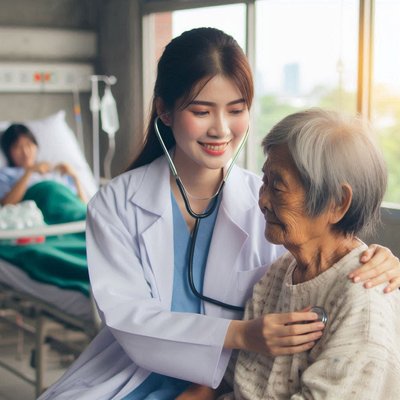

Previously, I have written detailed blogs on various sectors of Pakistan, such as universities, transportation, schools, etc. This blog is another addition to that series. Just like there is a mafia in the transportation sector, there is also a mafia in the hospital sector in Pakistan. In transportation, only private individuals are directly responsible, but here both government and private entities are taking advantage. A hospital is supposed to be a welfare institution, aimed at caring for patients and providing them with better facilities. However, apart from a few exceptions, these aspects are missing in Pakistani hospitals. The staff in government hospitals are negligent because they know they will receive their salaries regardless, while private hospitals exert every effort to extract as much money as possible from the patient's pocket, because this business will never end as long as there are patients in the world.
اس سے قبل میں پاکستان کے مختلف شعبوں مثلاً یونیورسٹی، ٹرانسپورٹیشن ،سکلوز وغیرہ پر تفصیلی بلاگز لکھ چکا ہوں. یہ بلاگ بھی اسی سلسلے کی ایک کڑی ہے. پاکستان میں ٹرانسپورٹیشن والوں کی طرح ہسپتال والوں کا بھی پورا ایک مافیا ہے. ٹرانسپورٹ میں تو چلو صرف پرائیویٹ افراد ہی بلاواسطہ قصوروار دکھائی دیتے ہیں مگر یہاں کیا سرکاری اور کیا غیر سرکاری، دونوں ہی بہتی گنگا میں ہاتھ دھو رہے ہیں. کہنے کو تو ہسپتال ایک فلاحی ادارہ ہے، جس کا کام مریضوں کی دیکھ بھال کرنا، ان کا خیال رکھنا، انہیں بہتر سہولیات فراہم کرنا ہے مگر پاکستانی ہسپتالوں میں چند ایک کو چھوڑ کر یہ چیزیں مفقود نظر آتی ہیں. سرکاری ہسپتال کا عملہ تو یہ سوچ کر کام سے عدم توجہی برتتا ہے کہ تنخواہ مل ہی جائے گی اور پرائیویٹ ہسپتال والے پورا زور لگاتے ہیں کہ جتنا پیسہ نکال سکتے ہیں، مریض کی جیب سے نکال لیا جائے، کیونکہ یہ کاروبار کبھی ختم نہیں ہونے والا، جب تک دنیا میں مریض زندہ ہیں، تب تک پیسہ آتا رہے گا.


Doctors or Dacoits?
First and foremost, the harshest criticism should be directed at those doctors who, in their childhood, used to say they would grow up to become doctors and provide free treatment to the poor. Now, after becoming doctors, they charge hefty fees just for consultation, not even treatment—sometimes 2,000, sometimes 3,000, and sometimes even 5,000 rupees. It’s not that they have no other means of earning. These doctors go to government hospitals in the morning, mark their nominal attendance, and return to open their private clinics in the evening, charging hefty fees for patient consultations. They draw hefty salaries from government hospitals and earn boundlessly from their clinics. Patients who visit them in government hospitals are quickly told to visit their private clinics in the evening for a more thorough examination. Such doctors are killers in the guise of healers. They are not doctors but dacoits, plundering people’s pockets.
ڈاکٹر یا ڈاکو؟
سب سے پہلے تو شدت اور ملامت کے مستحق وہ ڈاکٹر ہیں، جو بچپن میں کبھی یہ کہا کرتے تھے کہ میں بڑا ہو کر ڈاکٹر بنوں گا اور غریب عوام کا مفت علاج کروں گا. اب ڈاکٹر بننے کے بعد حال یہ ہے کہ مریض کو صرف دیکھنے کے، علاج کرنے کے نہیں، صرف دیکھنے کی فیس کہیں 2 ہزار کہیں 3 ہزار تو کہیں 5 ہزار لگا کر بیٹھے ہیں. ایسا نہیں ہے کہ ان کے پاس کمانے کو کچھ نہیں ہے، بلکہ یہ ڈاکٹر صبح سرکاری ہسپتالوں میں جاتے ہیں. وہاں برائے نام حاضری لگا کر واپس آجاتے ہیں. پھر شام کو واپس آکر اپنا ذاتی کلینک کھولتے ہیں، بھاری بھرکم فیس لے کر تسلی سے مریض کو دیکھتے ہیں. سرکاری ہسپتال سے بھی لاکھوں کی تنخواہ بٹورتے ہیں اور اپنے کلینک سے تو بے حساب کماتے ہیں. ہسپتال میں آنے والے مریضوں کو جلدی سے نمٹا کر کہہ دیتے ہیں کہ آپ شام کو میرے کلینک پر آجائیے گا، وہاں آپ کو تسلی سے دیکھ کر علاج کروں گا. ایسے ڈاکٹر مسیحا کے بھیس میں چھپے قاتل ہوتے ہیں. بلکہ یہ ڈاکٹر ہوتے ہی نہیں ہیں، یہ ڈاکو ہوتے ہیں ڈاکو. جو لوگوں کی جیبوں پر ڈاکہ ڈالتے ہیں.


Hospital Facilitators
It’s not just the hospital staff that falls into the category of dacoits but also their facilitators, who collectively turn hospitals into a mafia. These include medical stores, pharmacies, and pharmaceutical companies whose owners compromise patients' health to sell their medicines. Often, a specific doctor’s prescribed medicine is only available at the pharmacy next to his clinic. If it’s a common ailment, the medicine should be available at any medical store, but it’s not. This is because doctors receive commissions from companies and thus prescribe only their medications, no matter how expensive they are or how much of a burden they place on the patient. The more expensive the medication, the higher the commission and profit for the doctor. Thus, this spectacle continues openly.
ہسپتالوں کے سہولت کار:
ڈاکو کے زمرے میں صرف ہسپتال کا عملہ نہیں آتا بلکہ ان کے وہ سب سہولت کار آتے ہیں جن کے اشتراک سے ہسپتال ایک مافیا بن جاتا ہے. پھر چاہے وہ میڈیکل سٹورز یا فارمیسی والے ہوں، یا پھر دوائی بنانے والی کمپنیاں اور ان کے وہ مالکان جو محض اپنی دوائی بیچنے کی خاطر مریض کی طبیعت کا بیڑہ غرق کر دیتے ہیں. اکثر ایسا ہوتا ہے کہ جس مخصوص ڈاکٹر نے دوائی لکھی ہوگی، وہ اسی مخصوص ڈاکٹر کے کلینک کے ساتھ موجود فارمیسی سے ملے گی. بھلا جب دوائی عام سے مرض کی ہے تو اسے بھی عام دیگر میڈیکل سٹور پر مل جانا چاہیے. لیکن نہیں. کیونکہ یہاں پر ہر ڈاکٹر نے کمپنی سے الگ کمیشن لے رکھا ہوتا ہے جس کی وجہ سے وہ صرف اسی کمپنی کی دوائی لکھ کر دیتا ہے. پھر چاہے وہ کتنی ہی مہنگی کیوں نہ ہو، چاہے مریض کی جیب پر کتنی ہی بھاری کیوں نہ ہو. بلکہ ڈاکٹر تو خوشی خوشی مہنگی دوائی ہی لکھ کر دے گا کیونکہ اگر زیادہ مہنگی دوائی لکھے گا تو زیادہ کمیشن ملے گا اور زیادہ پیسہ آئے گا. یوں یہ تماشا سر عام چلتا رہتا ہے.


Genuine Healers
In every era, there are individuals whose presence makes the world appear somewhat better despite all the evils. Today, despite the rampant corruption, bribery, and deceit, some people deserve the title of real heroes. There are still hospitals in our society that provide completely free treatment. They do not charge any illegal fees. There are doctors whose mere conversation heals the patient. There is staff whose behavior alone brings comfort to the patient. Some private hospitals charge reasonable fees without exploiting people. If these few good institutions didn’t exist, who knows what state Pakistan would be in. You will often see crowds of poor people at these places. Understandably, the operational costs of a hospital are no secret. Various machines run daily, and philanthropists support these institutions to cover these expenses. Both types of institutions exist; the difference is that one is driven by greed, extracting money from people, while the other is supported by voluntary contributions, earning a good reputation while the other earns infamy.
اصلی مسیحا:
ہر زمانے میں ایسے لوگ ضرور پائے جاتے ہیں جن کی وجہ سے دنیا باوجود تمام تر برائیوں کے کسی قدر خوشحال دکھائی دیتی ہے. آج بھی باوجود رشوت خوری، دھونس اور فریب کے کچھ ایسے رجال کار موجود ہیں جنہیں حقیقی ہیرو کا خطاب دیا جانا چاہیے. آج بھی اسی معاشرے میں ایسے ہسپتال موجود ہیں جو مکمل علاج مفت کرتے ہیں. کسی قسم کی کوئی ناجائز فیس نہیں لیتے. ایسے ڈاکٹر موجود ہیں، جن سے بات کرکے ہی مریض کو شفا مل جاتی ہے. ایسا عملہ موجود ہے، جس کے رویہ کی بدولت ہی مریض پرسکون ہو جاتا ہے. ایسے بھی پرائیویٹ ہسپتال ہیں جہاں مناسب فیس لی جاتی ہے. لوگوں کو لوٹا نہیں جاتا. اگر یہ چند اچھے ادارے نہ ہوتے تو نہ جانے پاکستان کس حال میں ہوتا. ایسی جگہوں پر اکثر آپ کو غریبوں کا رش دیکھنے کو ملے گا. یقینی سی بات ہے کہ ہسپتال کے آپریشنل اخراجات بھی کسی سے ڈھکے چھپے نہیں ہیں. روزانہ کئی قسم کی مشینیں چلتی ہیں، ان سب اخراجات کو پورا کرنے کے لیے مخیر حضرات ایسے اداروں کے ساتھ تعاون کرتے ہیں. اب دونوں قسم کے ادارے چل تو رہے ہیں. بس فرق یہ ہے کہ ایک میں حرص و طمع زیادہ ہے تو وہ اپنی لالچ کی وجہ سے لوگوں کی جیبوں سے کھینچ کھینچ کر پیسے نکال رہا ہے اور دوسرے ادارے میں لوگ از خود آ کر پیسے جمع کروا جاتے ہیں. ایک کی نیک نامی ہوتی ہے تو دوسرے کی بدنامی.


Conclusion
From my analysis, I conclude that if the government reforms its public institutions to provide free medical aid, half of the health issues of the Pakistani population can be resolved. Otherwise, if the government fails to do so, the public should boycott such expensive hospitals where they are being exploited. If people collectively and effectively run a boycott campaign, they can put a stop to these exploiters. I aspire to build a beautiful and bright future for my coming generations, a future that we can proudly hand over to them. They should grow up in an environment of freedom, prosperity, and health, striving for the nation's progress and moving forward continuously.
نتیجہ:
میں اپنے تجزیہ کے نتیجے میں اس بات پر پہنچا ہوں کہ اگر حکومت اپنے سرکاری اداروں کے معاملات درست کر لے، تاکہ وہاں مریضوں کو مفت طبی امداد مل سکے تو پاکستانی عوام کے صحت کے آدھے مسائل یوں حل ہو سکتے ہیں. بصورت دیگر اگر حکومت ایسا نہیں کرتی ہے تو عوام کو چاہیے کہ وہ ایسے مہنگے ہسپتالوں کا بائیکاٹ کریں، جہاں پر ان کا مال دونوں ہاتھوں سے لوٹا جا رہا ہے. اگر عوام اکٹھے ہو کر مؤثر انداز میں بائیکاٹ کی مہم چلائیں تو ان مگرمچھوں کے منہ پر نتھ باندھ سکتے ہیں. میں تو چاہتا ہوں کہ میں اپنی آنے والی نسل کے لیے ایک ایسا خوبصورت اور خوشنما مستقبل تعمیر کروں، جسے ہمیں اپنی نسلوں کے حوالے کرتے ہوئے بھی خوشی ملے. ایک آزاد، خوشحال اور صحت مند مملکت کے ماحول میں سانس لے کر وہ پلیں بڑھیں اور ملک و قوم کی ترقی کی جستجو میں آگے سے آگے بڑھتے چلے جائیں.

Join Binance through THIS LINK for 10% off trading fees! Let's save together!
ٹریڈنگ فیس میں 10% چھوٹ کے لیے اس لنک کے ذریعے بائننس میں شامل ہوں! آئیے مل کر بچائیں!

